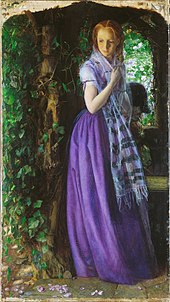
Summary
Arthur Hughes (27 January 1832 – 22 December 1915) was an English painter and illustrator associated with the Pre-Raphaelite Brotherhood.



Biography edit
Hughes was born in London. In 1846 he entered the art school at Somerset House, his first master being Alfred Stevens, and later entered the Royal Academy schools. It was here, after reading a copy of The Germ, that he met John Everett Millais, Holman Hunt, and Dante Gabriel Rossetti, although he never became an official member of the Pre-Raphaelite group of painters.[1] His first picture, Musidora, was hung at the Royal Academy when he was only 17, and thenceforth he contributed almost annually not only to the Royal Academy but later also to the Grosvenor and New Gallery exhibitions.[2] After having his painting Ophelia hung near Millais' version of the same name, they became friends and Hughes served as the model for the male figure in The Proscribed Royalist.[3]
In 1855 Hughes married Tryphena Foord, his model for April Love. They had five children of whom one, Arthur Foord Hughes,[4] also became a painter. Hughes died in Kew Green, London in 1915,[5] leaving about 700 known paintings and drawings, along with over 750 book illustrations. Following the death of Tryphena Hughes in 1921, their daughter Emily had to move to a smaller house. There was, therefore, a shortage of space. As a result, she had her father's remaining preparatory sketches, and all his private papers and correspondence, destroyed. He was the uncle of Edward Robert Hughes.
Hughes is buried in Richmond Cemetery.[6]
Works edit
His best-known paintings are April Love and The Long Engagement, both of which depict troubled couples contemplating the transience of love and beauty. They were inspired by John Everett Millais's earlier "couple" paintings but place far greater emphasis on the pathos of human inability to maintain the freshness of youthful feeling in comparison to the regenerative power of nature. April Love was purchased from Hughes by William Morris.
Like Millais, Hughes also painted Ophelia (which is housed at Toledo Museum of Art) and illustrated Keats's poem The Eve of St. Agnes. Hughes's version of the latter is in the form of a secular triptych, a technique he repeated for scenes from Shakespeare's As You Like It. His works are noted for their magical, glowing colouring and delicate draughtsmanship.
The oil portrait Springtide, first exhibited in Dublin in 1855, features his wife Tryphena.
In 1857 Hughes was persuaded by Dante Gabriel Rossetti to join with the group of young artists who were to head to Oxford to paint the walls of the newly-finished debating chamber of the Oxford Union Society. Rossetti had chosen the Legend of King Arthur as the theme of frescoes and Hughes was delegated to paint a panel depicting The Death of Arthur. Unfortunately the walls were not properly prepared for the paintings and they soon deteriorated and now only the barest outlines remain of the works.[7]
Illustrations edit
Although most of Hughes' later paintings are not well regarded, it is considered that the black and white drawings of his later career were some of his best. He illustrated several books, including Tom Brown’s Schooldays (1869), George Macdonald's At the Back of the North Wind (1871) and The Princess and the Goblin (1872) and Christina Rossetti’s Sing Song (1872) and Speaking Likenesses (1874).[8]
He also produced numerous illustrations for Norman MacLeod's monthly magazine, Good Words.
-
The King's Orchard
-
Musidora Bathing
-
That was a Piedmontese ...
-
Rosalind in As You Like It
-
The Potter's Courtship
-
Margaret Lushington, Mrs Stephen Langton Massingberd
See also edit
- List of Pre-Raphaelite paintings - includes catalogue of Arthur Hughes' work with links to individual paintings' articles.
- List of British painters
Notes edit
- ^ Treuherz, Julian (2003). "Arthur Hughes". Grove Art Online. doi:10.1093/gao/9781884446054.article.T039317. ISBN 978-1-884446-05-4. Retrieved 29 April 2019.
- ^ One or more of the preceding sentences incorporates text from a publication now in the public domain: Chisholm, Hugh, ed. (1922). "Hughes, Arthur". Encyclopædia Britannica (12th ed.). London & New York: The Encyclopædia Britannica Company.
- ^ "Arthur Hughes, portrait study for 'The Proscribed Royalist'". Royal Academy of Arts. Retrieved 11 April 2019.
- ^ "Four Figure Studies". Birmingham Museums & Art Gallery. Retrieved 4 January 2016.
- ^ "Death of a well-known artist". Western Daily Press. 24 December 1915. Retrieved 22 January 2016.
- ^ Meller, Hugh; Parsons, Brian (2011). London Cemeteries: An Illustrated Guide and Gazetteer (fifth ed.). Stroud, Gloucestershire: The History Press. pp. 290–294. ISBN 9780752461830.
- ^ Morrah, Herbert Arthur (1923). The Oxford Union 1823-1923. London: Cassell and Sons. pp. 166–191.
- ^ Ray, Gordon Norton (1991). The Illustrator and the Book in England from 1790 to 1914. Courier Corporation. pp. 108–111. ISBN 9780486269559.
External links edit
- Hughes: Pre-Raphaelite Painter & Book Illustrator (archive copy at archive.org)
- Arthur Hughes at PreRaphaelites.org, Birmingham Museums & Art Gallery
- Works by Arthur Hughes at Project Gutenberg
- Works by or about Arthur Hughes at Internet Archive
- Hughes at ArtMagick.com (archived 2006-10-23)
- Arthur Hughes at Invaluable.com
- Arthur Hughes at Library of Congress, with 20 library catalogue records
- 66 artworks by or after Arthur Hughes at the Art UK site


